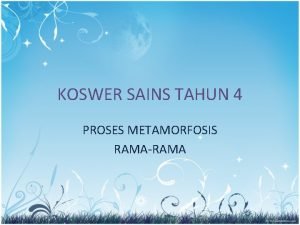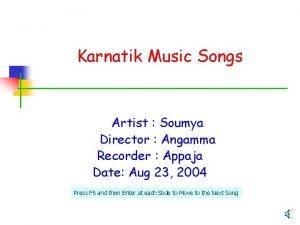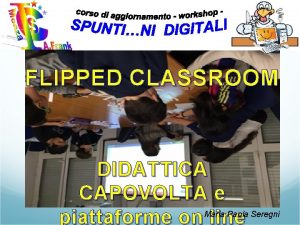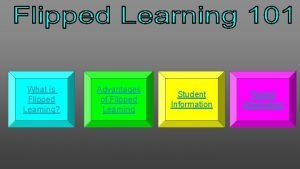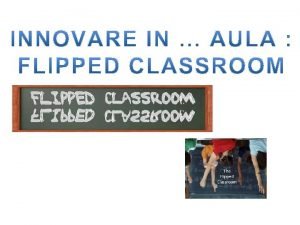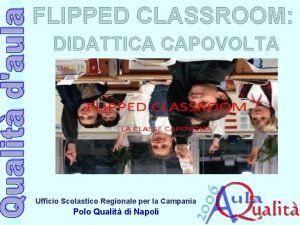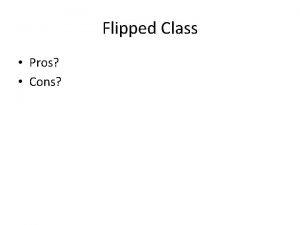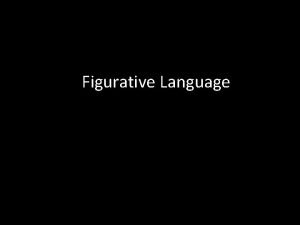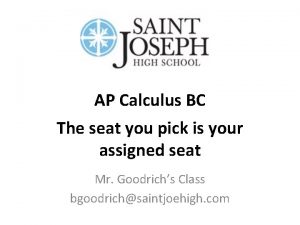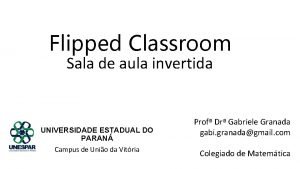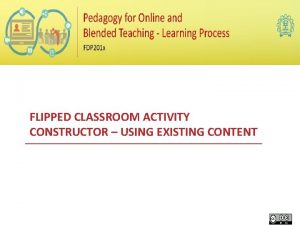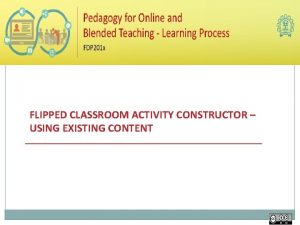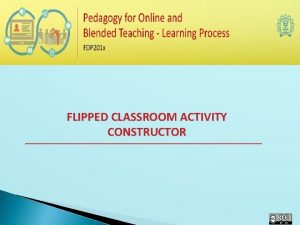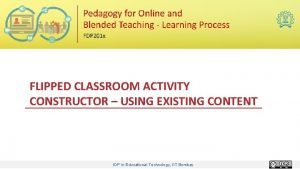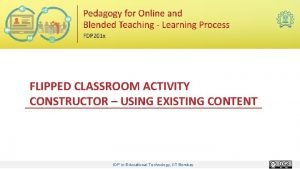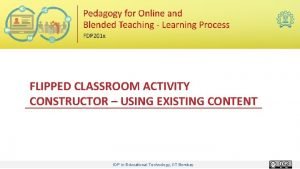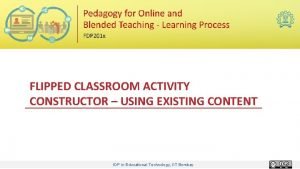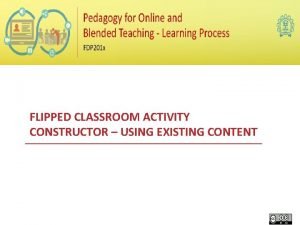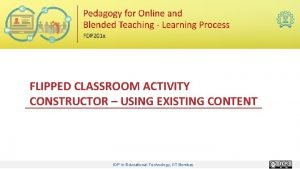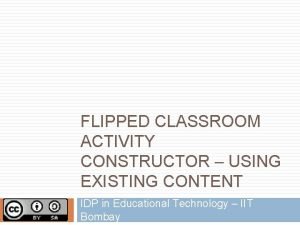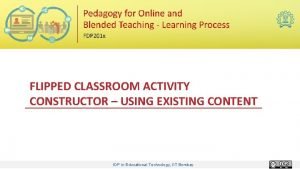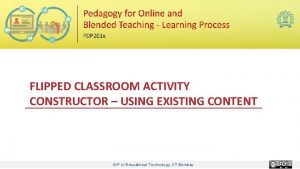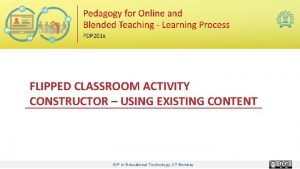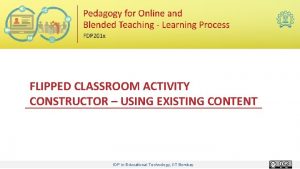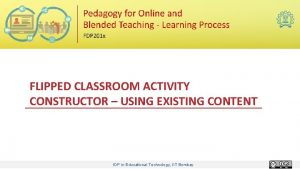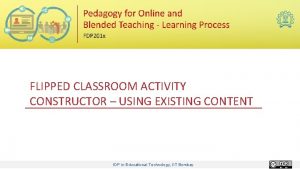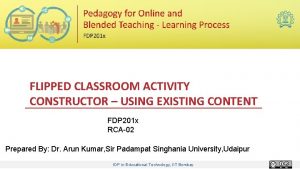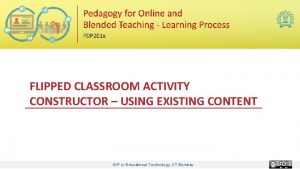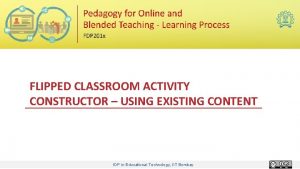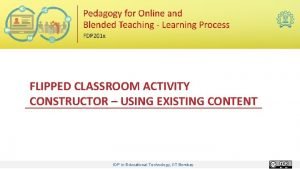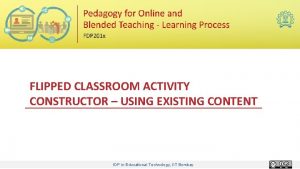FLIPPED CLASSROOM ACTIVITY CONSTRUCTOR USING EXISTING CONTENT Rama






















- Slides: 22

FLIPPED CLASSROOM ACTIVITY CONSTRUCTOR – USING EXISTING CONTENT

Rama Subrahmanyam Komaragiri Basic Laws in Electronics Basic Electrical Engineering ELECTRICAL All 1 ST YEAR ENGINEERING STUDENTS Department of ECE, Bennett University 2

Out-of-class Activity Design -1 Learning Objective(s) of Out-of-Class Activity After watching the video, the learner should be able to: 1. Explain Kirchhoff's Laws (Knowledge Level) in his own words 2. Apply Kirchhoff's laws to a given circuit to determine voltage or current (Apply Level) 3. Calculate maximum power transferred to a load resistor using maximum power transfer theorem (Apply Level) 4. Apply Superposition theorem to find a current or voltage in a circuit (Apply Level) Key Concept(s) to be covered 1. Kirchhoff's laws 2. Maximum Power Transfer Theorem 3. Superposition Theorem Department of ECE, Bennett University 3

Out-of-class Activity Design - 2 Main Video Source URL https: //www. youtube. com/watch? v=vf. VVF 58 Ft. Cc&feature=youtu. be Standard You. Tube License (obtained permission form the author of the License of Video Mapping Concept to Videovideo) Source CONCEPT VIDEO SEGMENT DURATION (in min) Kirchhoff’s Current law Video 1: Video-1_KCL 6. 58 Kirchhoff’s Voltage law Video 2: Video-2_KVL 9. 45 Video 3: Video-3_Maximum_Power_Transfer_Theorem 7. 92 Video 4: Video-4_Superposition_Theorem 9. 60 Maximum Power Transfer Theorem Superposition Theorem TOTAL DURATION 33. 55 min Department of ECE, Bennett University 4

Out-of-class Activity Design - 3 Aligning Assessment with Learning Objective Define 1) Kirchhoff's Laws (Knowledge 2) Level) Assessment Strategy Mathematically express Kirchhoff’s Current Law. If a current flows out of a node what is the sign assigned to the current? Expected Duration (in min) Additional Instructions (if any) 4 minutes Watch Video-1_KCL to answer Q 1 and Q 2. To answer Q 1, pause the video at timestamp 1: 33. After answering, restart the video. To answer Q 2, pause the video at timestamp 2: 18. After answering, restart the video. Check your answer by viewing video till timestamp 6: 25. Correct answer for each question in first attempt results in 2 points. Every extra attempt reduces marks by 20%. Deadline to submit: By 10: 00 PM the day before lecture. Department of ECE, Bennett University 5

Out-of-class Activity Design - 3 Aligning Assessment with Learning Objective Define 3) Kirchhoff's Laws (Knowledge 4) Level) Assessment Strategy In your own words, explain KVL. While applying KVL to loop, if one moves from positive to negative of a voltage source, what is the sign of the current flowing through the voltage source? Expected Duration (in min) Additional Instructions (if any) 4 minutes Watch Video-2_KVL to answer Q 3 and Q 4. To answer Q 3, pause the video at timestamp 2: 04. After answering, restart the video. To answer Q 4, pause the video at timestamp 3: 44. After answering, restart the video. Check your answer by viewing video till timestamp 8: 59. Correct answer for each question in first attempt results in 2 points. Every extra attempt reduces marks by 20%. Deadline to submit: By 10: 00 PM the day before lecture. Department of ECE, Bennett University 6

Out-of-class Activity Design - 3 Aligning Assessment with Learning Objective Apply Kirchhoff's laws to a given circuit to determine voltage or current (Apply Level) Assessment Strategy 5) Expected Duration (in min) Additional Instructions (if any) 4 minutes Watch Video-1_KCL video segment between timestamp 2: 37 – 4: 56 to answer Q 5. Correct answer the above question results in 4 points. The total amount of attempts is limited to 5. Deadline to submit: By 10: 00 PM the day before lecture. Using Kirchhoff’s laws, find the currents in the circuit. Department of ECE, Bennett University 7

Out-of-class Activity Design - 3 Aligning Assessment with Learning Objective Apply Kirchhoff's laws to a given circuit to determine voltage or current (Apply Level) Assessment Strategy 6) Expected Duration (in min) Using Kirchhoff’s laws, find the voltages in circuit (B). 4 minutes Department of ECE, Bennett University Additional Instructions (if any) Watch Video-2_KVL video segment between timestamp 3: 44 – 9: 05 to answer Q 6. Correct answer the above question results in 4 points. The total amount of attempts is limited to 5. Deadline to submit: By 10: 00 PM the day before lecture. 8

Out-of-class Activity Design - 3 Aligning Assessment with Learning Objective Calculate maximum power transferred to a load (Apply Level) Assessment Strategy 7) Expected Duration (in min) Additional Instructions (if any) 2 minutes To answer Q 7, Watch Video 3_Maximum_Power_Transfer_Theorem and pause the video at timestamp 3: 33. After answering, restart the video. Correct answer for each question in first attempt results in 2 points. Every extra attempt reduces marks by 20%. Deadline to submit: By 10: 00 PM the day before lecture. In your words, explain when maximum power transferred to a load? Department of ECE, Bennett University 9

Out-of-class Activity Design - 3 Aligning Assessment with Learning Objective Calculate maximum power transferred to a load (Apply Level) Assessment Strategy 8) Expected Duration (in min) Additional Instructions (if any) 3 minutes To answer Q 8, Watch Video 3_Maximum_Power_Transfer_Theorem and pause the video at timestamp 7: 24. After answering, restart the video. Correct answer the above question results in 4 points. The total amount of attempts is limited to 5. Deadline to submit: By 10: 00 PM the day before lecture. Find the Resistance RS such that maximum power is transferred to the 6 k. W load. Department of ECE, Bennett University 10

Out-of-class Activity Design - 3 Aligning Assessment with Learning Objective Apply Superposition Theorem to find a current or voltage in a circuit (Apply Level) Assessment Strategy 9) Expected Duration (in min) Additional Instructions (if any) 10 minutes To answer Q 9, Watch Video 4_Superposition_Theorem and pause the video at timestamp 5: 32. Remove one source and find the current through 12 k. W resistor and then repeat the process for the other voltage source. Restart the video. Check your process by watching video segment between timestamp 5: 33 to 9: 06. Correct answer the above question results in 4 points. The total amount of attempts is limited to 5. Deadline to submit: By 10: 00 PM the day before lecture. By using superposition theorem, the voltage drop across the 12 k. W resistor. Total activity duration: 31 minutes Department of ECE, Bennett University 11

In-class Activity Design -1 Learning Objective(s) of In - Class Activity At the end of the class, students will be able to, Compute the power delivered by complex circuits (ANALYZE Level) Apply superposition theorem to simplify a circuit (ANALYZE Level) • • Key Concept(s) to be covered § Applying basic laws to a given circuit (those laws that are discussed in this learning resource) § Limitations of Superposition theorem Department of ECE, Bennett University 12

In-class Activity Design -2 Active Learning activity(ies) that you plan to do Concept clarification using § Peer Instruction Finding the limitations of superposition theorem using. § Think-SOlo-Pair-Share (TOPS) Department of ECE, Bennett University 13

In-class Activity Design -2 Peer Instruction Strategy – What Teacher Does At the starting of the class, teacher provides summary of the basic laws used to simplify the electrical circuits. Two PI questions were asked. First PI question as below is asked. Q 1: Using Kirchhoff’s laws, Calculate the power consumed by the resistor R L. What is the value of RL if the power consumed is maximum. are your observations. Department of ECE, Bennett University 14

In-class Activity Design -2 Peer Instruction Strategy – What Teacher Does Q 2: Apply superposition theorem to calculate the power consumed by the 4 k. W resistor. Department of ECE, Bennett University 15

In-class Activity Design -2 Peer Instruction Strategy – What Student Does § § § For each question they will first answer individually. Then they will discuss with peers and come to consensus. Listen to instructors explanation. Department of ECE, Bennett University 16

In-class Activity Design -2 TOPS Strategy – What Instructor does Teacher asks the following question. Is the power consumed by a load resistor due to individual sources in a circuit adds up to the power consumed by the load resistor due to all sources put together? Department of ECE, Bennett University 17

In-class Activity Design -2 TOPS Strategy – What Instructor does Think (~2 minutes) Instruction: Students were asked to think on the relation between voltage (polarity) across a resistor and current through a resistor (direction of current) and link it to the sign of the power consumed by a resistor. Then apply the thinking to “Is the power consumed by a load resistor due to individual sources in a circuit adds up to the power consumed by the load resistor due to all sources put together? ” Department of ECE, Bennett University 18

In-class Activity Design -2 TOPS Strategy – What Instructor does Solo (~10 minutes) Now teacher re-opens Q 2 with the following question. Calculate the power consumed by the 4 k. W resistor individually due to 8 m. A current source (P 1) and due to 12 V source (P 2). Is this power equal to the total power as calculated in (Q 1)? What are your observations and reasons behind your observations. Department of ECE, Bennett University 19

In-class Activity Design -2 TOPS Strategy – What Instructor does Pair (~5 minutes) Instruction: Now pair up and compare your answers. Agree on one final answer. While students are pairing and discussing, instructor goes to 2~3 sections to see what they are doing. Department of ECE, Bennett University 20

In-class Activity Design -2 TOPS Strategy – What Instructor does Share (~8 minutes) Instructor asks a group to share their answer with class and see whethere are different answers. After sharing is done, instructor gives feedback on the correct solution on why the power delivered to load resistance by individual power sources doesn’t adds up to the power delivered to the load resistance by keeping all the power sources together. Department of ECE, Bennett University 21

In-class Activity Design -2 Justify why the above is an active learning strategy In both the above strategies, students • are required to go beyond mere listening and execution of prescribed steps. • are required to think deeply about the content they were familiarized in out-of-class and do higher order thinking. • are required to work on their own to solve a problem in the class Finally, an immediate feedback is provided either through peer discussion or instructor summary Department of ECE, Bennett University 22
 Lagu dari ulat jadi kepompong
Lagu dari ulat jadi kepompong Sri rama sri rama sri manoharama
Sri rama sri rama sri manoharama Cosa prevede “inquiry flipped classroom”:
Cosa prevede “inquiry flipped classroom”: Flipped learning advantages and disadvantages
Flipped learning advantages and disadvantages I promessi sposi flipped classroom
I promessi sposi flipped classroom Moodle beal
Moodle beal Didattica capovolta
Didattica capovolta Bioengineering flipped classroom
Bioengineering flipped classroom Flipped classroom
Flipped classroom Flipped classroom model
Flipped classroom model Flipped classroom pros and cons
Flipped classroom pros and cons Sourima mal
Sourima mal Mastery of content
Mastery of content Carrier content and real content in esp
Carrier content and real content in esp Static content vs dynamic content
Static content vs dynamic content Flipped book setting
Flipped book setting Flipped advising
Flipped advising Flipped up their noses like goats
Flipped up their noses like goats Relational calculus calculator
Relational calculus calculator Flipped sum of its parts
Flipped sum of its parts Classroom
Classroom Flipped
Flipped Marcus biel
Marcus biel
